Students looking for the Bridges in Mathematics Grade 5 Student Book Answer Key Unit 7 Module 3 can find a better approach to solve the problems.
Bridges in Mathematics Grade 5 Student Book Answer Key Unit 7 Module 3
Bridges in Mathematics Grade 5 Student Book Unit 7 Module 3 Session 1 Answer Key
Exponents & Powers of Ten
When you multiply 10s together, like 10 × 10 × 10, the product is called a power of 10. You can use an exponent to show a power of 10. The exponent tells how many times to multiply 10 by itself.
Question 1.
Complete the chart below to show different powers of 10.
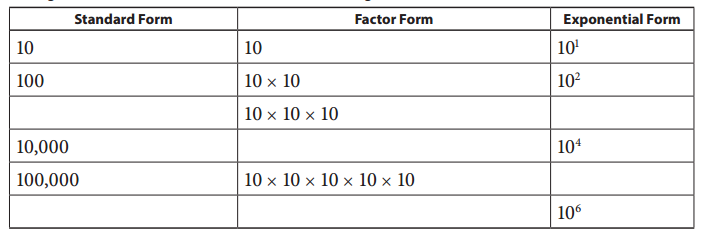
Answer:
The power of 10 can be calculated by counting the number of times 10 is multiplying by itself.

Question 2.
Multiply each whole number by powers of 10, using the steps shown in the example.
ex: 43 × 102 = 43 × (10 × 10) = 43 × 100 = 4,300
a. 79 × 103 = _________________
Answer:
79 × (10 × 10 × 10)
79 × 1000
79000
b. 105 × 102 = _________________
Answer:
105 × (10 × 10)
105 × 100
10500
c. 4568 × 104 = ________________
Answer:
4568 × (10 × 10 × 10 × 10)
4568 × 10000
45680000
d. 17 × 105 = ________________
Answer:
17 × (10 × 10 × 10 × 10 × 10)
17 × 100000
1700000
Question 3.
Multiply each decimal by powers of 10, using the steps shown in the example.
ex 5.8 × 103 = 5.8 × (10 × 10 × 10) = 5.8 × 1,000 = 5,800
a. 4.7 × 103 = _________________
Answer:
4.7 × (10 × 10 × 10)
4.7 × 1000
4700
b. 0.68 × 102 = ________________
Answer:
0.68 × (10 × 10)
0.68 × 100
68
c. 5.16 × 104 = ________________
Answer:
5.16 × (10 × 10 × 10 × 10)
5.16 × 10000
51600
d. 12.63 × 105 = ________________
Answer:
12.63 × (10 × 10 × 10 × 10 × 10)
12.63 × 100000
1263000
Bridges in Mathematics Grade 5 Student Book Unit 7 Module 3 Session 2 Answer Key
Patterns in Multiplying by Powers of Ten
Question 1.
The post office sells 14 stamps. Fill out the table below to show how much it would cost to buy different quantities of 1¢ stamps.

a. What do you notice about multiplying by 0.01?
Answer:

Question 2.
Amelia feeds her pet lizard crickets. The pet store sells crickets for 104 each. Fill out the table below to show how much it would cost to buy different quantities of crickets.
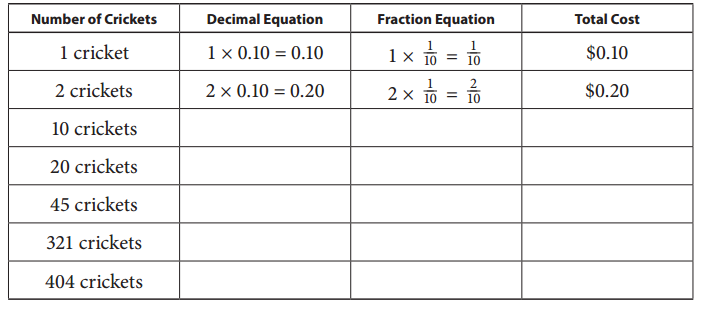
a. What do you notice about multiplying by 0.10?
Answer:

Question 3.
Alfonso’s company sells T-shirts to soccer teams. Each T-shirt costs $10. Fill out the table below to show how much it would cost to buy different quantities of T-shirts.
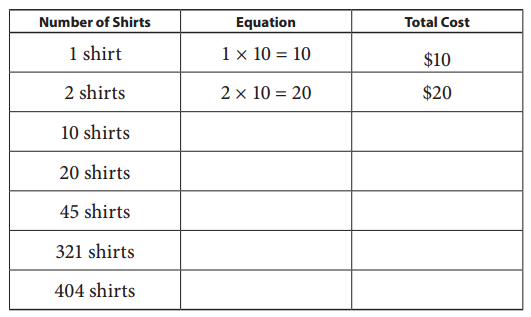
a. What do you notice about multiplying by 10?
Answer:

Multiplying by Powers of Ten Practice
106 × 0.01 = _______________
47 × 0.01 = _______________
3 × 0.01 = _______________
0.6 × 0.01 = _______________
0.32 × 0.01 = _______________
0.1 × 0.01 = _______________
10 × 0.01 = _______________
452 × 0.1 = _______________
302 × 0.1 = _______________
64 × 0.1 = _______________
0.9 × 0.1 = _______________
0.57 × 0.1 = _______________
0.04 × 0.1 = _______________
0.1 × 0.1 = _______________
360 × 10 = _______________
23 × 10 = _______________
4 × 10 = _______________
0.7 × 10 = _______________
0.54 × 10 = _______________
0.01 × 10 = _______________
0.32 × 100 = _______________
4.3 × 100 = _______________
4 × 100 = _______________
45 × 100 = _______________
309 × 100 = _______________
0.1 × 100 = _______________
0.17 × 1,000 = _______________
0.34 × 1,000 = _______________
9.6 × 1,000 = _______________
603 × 1,000 = _______________
0.01 × 1,000 = _______________
Answer:
106 × 0.01 = 106 × \(\frac{1}{100}\) = 1.06
47 × 0.01 = 47 × \(\frac{1}{100}\) = 0.47
3 × 0.01 = 3 × \(\frac{1}{100}\) = 0.03
0.6 × 0.01 = 6 × \(\frac{1}{10}\) × \(\frac{1}{100}\) = 0.006
0.32 × 0.01 = 32 × \(\frac{1}{100}\) × \(\frac{1}{100}\) = \(\frac{32}{10000}\) = 0.0032
0.1 × 0.01 = 1 × \(\frac{1}{10}\) × \(\frac{1}{100}\) = 0.001
10 × 0.01 = 10 × \(\frac{1}{100}\) = \(\frac{1}{10}\) = 0.1
452 × 0.1 = 452 × \(\frac{1}{10}\) = 45.2
302 × 0.1 = 302 × \(\frac{1}{10}\) = 30.2
64 × 0.1 = 64 × \(\frac{1}{10}\) = 6.4
0.9 × 0.1 = 9 × \(\frac{1}{10}\) × \(\frac{1}{10}\) = 0.09
0.57 × 0.1 = 57 × \(\frac{1}{100}\) × \(\frac{1}{10}\) = 57 × \(\frac{1}{1000}\) = 0.057
0.04 × 0.1 = 4 × \(\frac{1}{100}\) × \(\frac{1}{10}\) = 4 × \(\frac{1}{1000}\) = 0.004
0.1 × 0.1 = \(\frac{1}{10}\) × \(\frac{1}{10}\) = 0.01
360 × 10 = 3600
23 × 10 = 230
4 × 10 = 40
0.7 × 10 = 7 × \(\frac{1}{10}\) × 10 = 7
0.54 × 10 = 54 × \(\frac{1}{100}\) × 10 = 5.4
0.01 × 10 = 1 × \(\frac{1}{100}\) × 10 = 0.1
0.32 × 100 = 32 × \(\frac{1}{100}\) × 100 = 32
4.3 × 100 = 43 × \(\frac{1}{10}\) × 100 = 430
4 × 100 = 400
45 × 100 = 4500
309 × 100 = 30900
0.1 × 100 = 1 × \(\frac{1}{10}\) × 100 = 10
0.17 × 1,000 = 17 × \(\frac{1}{100}\) × 1000 = 170
0.34 × 1,000 = 34 × \(\frac{1}{100}\) × 1000 = 340
9.6 × 1,000 = 96 × \(\frac{1}{10}\) × 1000 = 9600
603 × 1,000 = 603,000
0.01 × 1,000 = 1 × \(\frac{1}{100}\) × 1000 = 10
More Exponents & Powers of Ten
Question 1.
Multiply each number by powers of 10, using the steps shown in the example.
ex: 29 × 103 = 29 × (10 × 10 × 10) = 29 × 1,000 = 29,000
ex: 7.2 × 103 = 7.2 × (10 × 10 × 10) = 7.2 × 1,000 = 7,200
a. 62 × 103 = _______________
Answer:
62 × (10 × 10 × 10)
62 × 1000
62000
b. 2,078 × 102 = _______________
Answer:
2078 × (10 × 10)
2078 × 100
207,800
c. 47 × 104 = _______________
Answer:
47 × (10 × 10 × 10 × 10)
47 × 10000
470000
d. 6.8 × 103 = _______________
Answer:
6.8 × (10 × 10 × 10)
6.8 × 1000
6800
e 0.098 × 103 = _______________
Answer:
0.098 × (10 × 10 × 10)
98
f. 26.75 × 104 = _______________
Answer:
26.75 × (10 × 10 × 10 × 10)
26.75 × 10000
267500
Question 2.
Sara solved the problems below, and got all the answers correct.
76 × 101 = 76
76 × 102 = 7,600
76 × 103 = 76,000
76 × 104 = 760,000
a. Describe what is happening to the number of zeros in these problems.
Answer:
The number of zeros in these problems is incraesing.
b. Explain why it works that way.
Answer:
As the power of 10 is increasing, the number of zeroes are increasing.
In 2012, the estimated population of Chicago, Illinois, was 2,714,856. The chart below shows four different ways to write this number.

Question 3.
Use the information shown above to help write the 2012 estimated population of Los Angeles, California, in word, expanded, and exponential form. (The standard form is written in for you.)

Answer:

Bridges in Mathematics Grade 5 Student Book Unit 7 Module 3 Session 3 Answer Key
Patterns in Dividing by Powers of Ten
Question 1.
Alfonso’s company sells T-shirts to soccer teams. Each T-shirt costs $10.
a. If you spent $1,030, how many shirts could you buy?
Answer:
Given that Alfonso’s company sells T-shirts to soccer teams costing $10.
If $1,030 is spent, 1030÷10 = 103
103 shirts can be bought.
b. Fill out the table below to show how many T-shirts you could buy with different amounts of money.
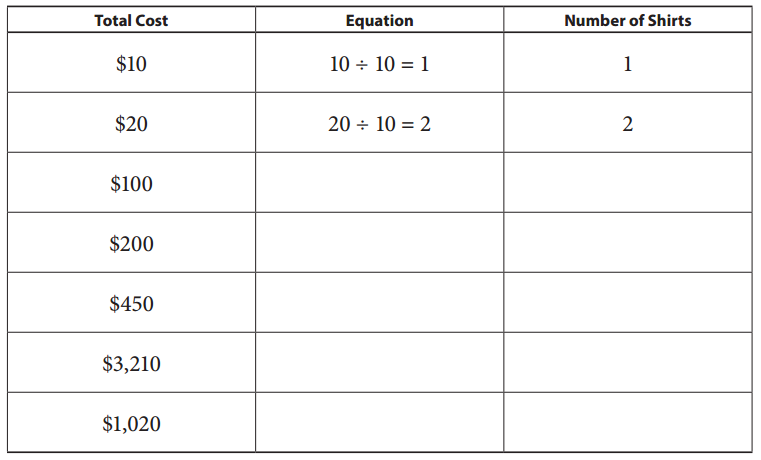
Answer:

c. What do you notice about dividing by 10?
Answer:
Dividing by 10 will decrease the number.
Question 2.
Amelia feeds her pet lizard crickets. The pet store sells crickets for 10¢ each.
a. If Amelia spent $1.30 on crickets last week, how many crickets did she buy?
Answer:
Given that the pet store sells crickets for 10¢ each and Amelia spent $1.30 on crickets last week.
1 dollar equals 100 cents. 10¢ will be equal to $0.1
To calculate the number of crickets, divide 1.30 by 0.1 which will be 13
Thus, she will buy 13 crickets.
b. Fill out the table below to show how much it would cost to buy different quantities of crickets.
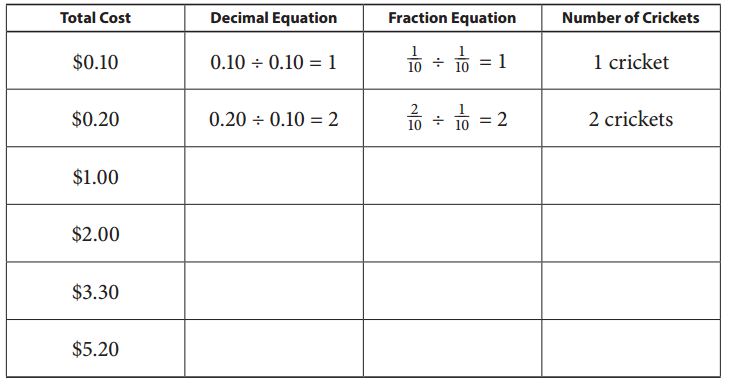
Answer:

c. What do you notice about dividing by 0.10?
Answer:
Dividing by 0.10 will increase the number value.
Question 3.
The post office sells 14 stamps.
a. If you spent $2.08, how many 14 stamps could you buy?
Answer:
Given that the post office sells 14 stamps.
If $2.08 is spent, 2.08÷0.01 = 208 stamps can be bought.
b. Fill out the table below to show how many stamps you could buy with different amounts of money.

Answer:
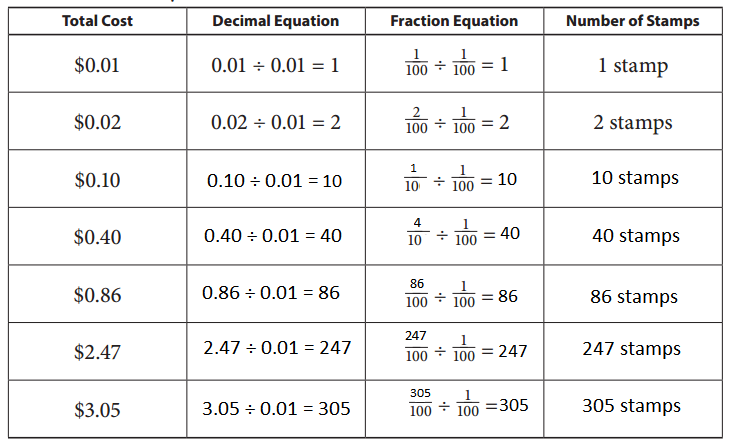
c. What do you notice about dividing by 0.01?
Answer:
Dividing by 0.10 will increase the numbers.
Dividing by Powers of Ten Practice
Complete the following equations.
3000 ÷ 1000 = ______________
2504 ÷ 1000 = ______________
372 ÷ 1000 = ______________
0.6 ÷ 1000 = ______________
0.03 ÷ 1000 = ______________
900 ÷ 100 = ______________
406 ÷ 100 = ______________
7 ÷ 100 = ______________
3.2 ÷ 100 = ______________
0.08 ÷ 100 = ______________
405 ÷ 10 = ______________
0.63 ÷ 10 = ______________
87 ÷ 0.1 = ______________
6 ÷ 0.1 = ______________
0.5 ÷ 0.1 = ______________
0.48 ÷ 0.1 = ______________
3 ÷ 0.01 = ______________
6.9 ÷ 0.01 = ______________
0.8 ÷ 0.01 = ______________
409 ÷ 0.01 = ______________
Answer:
3000 ÷ 1000 = 3
2504 ÷ 1000 = 2.504
372 ÷ 1000 = 0.372
0.6 ÷ 1000 = 0.0006
0.03 ÷ 1000 = 0.00003
900 ÷ 100 = 9
406 ÷ 100 = 4.06
7 ÷ 100 = 0.07
3.2 ÷ 100 = 0.032
0.08 ÷ 100 = 0.0008
405 ÷ 10 = 40.5
0.63 ÷ 10 = 0.063
87 ÷ 0.1 = 870
6 ÷ 0.1 = 60
0.5 ÷ 0.1 = 5
0.48 ÷ 0.1 = 4.8
3 ÷ 0.01 = 300
6.9 ÷ 0.01 = 690
0.8 ÷ 0.01 = 80
409 ÷ 0.01 = 40900
Multiplying & Dividing by Powers of Ten
Question 1.
Solve the multiplication problems below.
34 × 0.01 = ______________
34 × 0.10 = ______________
34 × 1 = ______________
34 × 10 = ______________
34 × 100 = ______________
34 × 1,000 = ______________
Answer:
34 × 0.01 = 0.34
34 × 0.10 = 3.4
34 × 1 = 34
34 × 10 = 340
34 × 100 = 3400
34 × 1,000 = 34,000
Question 2.
Solve the division problems below.
34 ÷ 0.01 = ______________
34 ÷ 0.10 = ______________
34 ÷ 1 = ______________
34 ÷ 10 = ______________
34 ÷ 100 = ______________
34 ÷ 1,000 = ______________
Answer:
34 ÷ 0.01 = 3400
34 ÷ 0.10 = 340
34 ÷ 1 = 34
34 ÷ 10 = 3.4
34 ÷ 100 = 0.34
34 ÷ 1,000 = 0.034
Question 3.
What patterns do you notice in the equations you completed above?
Answer:
When two numbers are multiplied, the result will be more in value.
When two numbers are divided, the result will be less than the numbers.
Question 4.
Solve the multiplication and division problems below.
62 ÷ 100 = ______________
3.4 × 1000 = ______________
7.89 ÷ 0.10 = ______________
0.43 × 100 = ______________
0.08 × 0.01 = ______________
123.05 ÷ 100 = ______________
Answer:
62 ÷ 100 = 0.62
3.4 × 1000 = 3400
7.89 ÷ 0.10 = 789
0.43 × 100 = 43
0.08 × 0.01 = 0.0008
123.05 ÷ 100 = 12305
Question 5.
Ramon bought erasers shaped like animals to give away at Family Night at his school. Each eraser costs $0.10. If he spent $25.60, how many erasers did he buy?
a. Write a division equation to represent this situation.
Answer:
The division equation to represent this situation will be 25.60 ÷ 0.10
b. Solve the problem using a strategy that makes sense to you. Show all your work.
Answer:
25.60 ÷ 0.10
25.60 ÷ \(\frac{1}{10}\)
25.60 × 10
256
Bridges in Mathematics Grade 5 Student Book Unit 7 Module 3 Session 4 Answer Key
Using the Area Model to Multiply Decimal Numbers
Question 1.
A piece of paper measures 0.3 m by 0.65 m.
a. Estimate the total area of the piece of paper.
Answer:
Given that a piece of paper measures 0.3 m by 0.65 m.
The total area of the piece of paper will be 0.3 × 0.6= 0.18 sq.m
b. Make a labeled sketch of the piece of paper and use it to calculate an exact answer.
Answer:
The total area of the piece of paper will be 0.3 × 0.65 = 0.195 sq.m
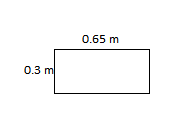
Question 2.
The city park measures 1.2 km by 0.63 km.
a. Estimate the total area of the park.
Answer:
Given that the city park measures 1.2 km by 0.63 km.
The estimated area wii be 1 × 0.6 = 0.6 sq.km
b. Make a labeled sketch of the park and use it to calculate an exact answer.
Answer:
The exact answer will be 0.63 × 1.2 = 0.756 sq.km

Question 3.
Use an algorithm or sketch arrays to find the products below.

Answer:
Step 1: Initially, ignore the decimal point and multiply the two numbers normally.
Step 2: After multiplication, count the number of decimal places in the decimal number. The product obtained after multiplication will have the same number of decimal places.
Step 3: Place the decimal point in the obtained product.

Multiplying Two Decimal Numbers
Question 1.
The memory card for Steve’s camera measures 0.82 inches by 1.25 inches.
a. What do you estimate the total area of the memory card is?
Answer:
Given that the memory card for Steve’s camera measures 0.82 inches by 1.25 inches.
The estimated area of the memory card will be 0.8 × 1.2 = 0.96 sq.in
b. Find the exact area of the memory card. Show all your work. Fill in the array below if it helps you.
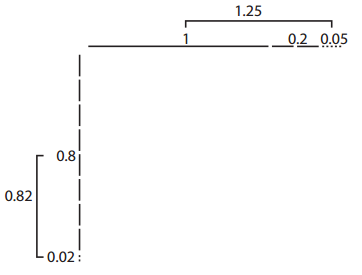
Answer:

Multiply the numbers to get the area of respective rectangles.
Add the obtained areas to get the complete area.
c. What is the place value of the smallest unit of area in the array above?
Answer:
The smallest unit of area is 0.001
The place value will be thousandths.
Question 2.
Fill in an estimate and the exact answer for the problems below. Show your work.
Estimate:

Exact Answer: ____________
Answer:
The estimated product will be 0.4 × 0.5 = 0.2

The actual answer will be 0.2240
Estimate:

Exact Answer: ____________
The estimated product will be 2 × 1 = 2
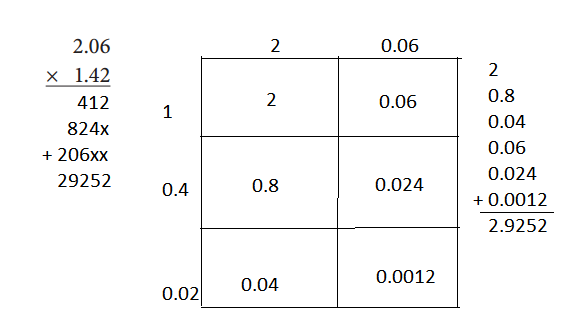
The exact product will be 2.06 × 1.42 = 2.9252
Estimate:

Exact Answer: ____________
The estimated product will be 3 × 0 = 0

The exact product will be 1.036